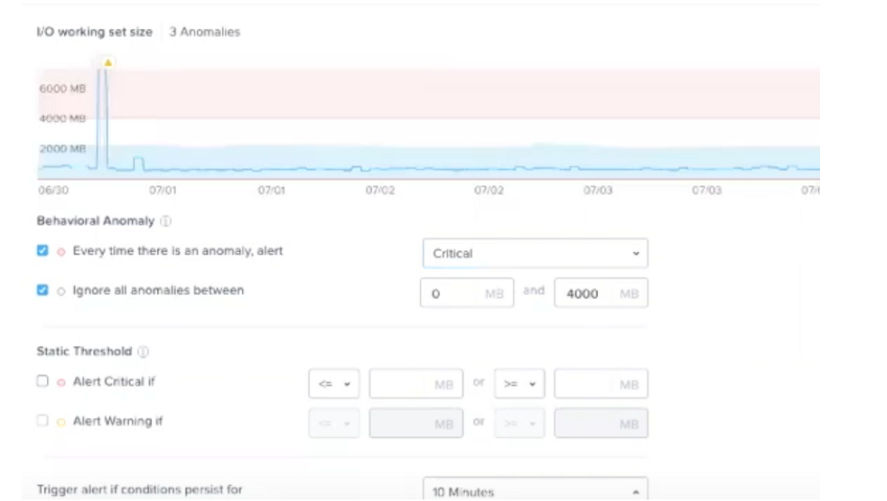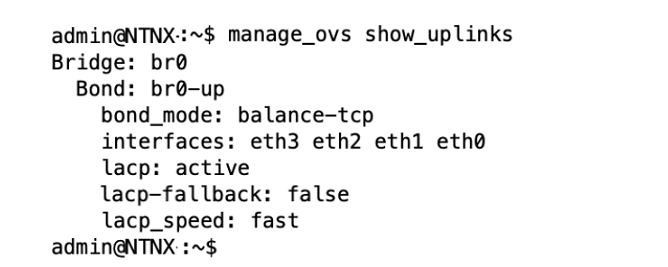Eliminate Risk of Failure with Nutanix NCP-MCI Exam Dumps
Schedule your time wisely to provide yourself sufficient time each day to prepare for the Nutanix NCP-MCI exam. Make time each day to study in a quiet place, as you'll need to thoroughly cover the material for the Nutanix Certified Professional - Multicloud Infrastructure v6.5 exam. Our actual Nutanix Certified Professional exam dumps help you in your preparation. Prepare for the Nutanix NCP-MCI exam with our NCP-MCI dumps every day if you want to succeed on your first try.
All Study Materials
Instant Downloads
24/7 costomer support
Satisfaction Guaranteed
Refer to Exhibit:

Which statement is true?
See the explanation below.
A) This statement is incorrect because there is no static threshold set to trigger a critical alert at 6000 MB. The graph shows a peak that goes above 6000 MB, but the alert configuration below does not specify a static threshold at this value.
B) This is the correct statement. The configuration under 'Behavioral Anomaly' is set to alert every time there is an anomaly, with a critical level alert set to trigger when the I/O working set size is between 0 MB and 4000 MB. The graph illustrates that the anomalies (highlighted in pink) occur when the working set size exceeds the normal range (blue band). Therefore, any anomaly detected above 4000 MB would trigger a critical alert.
C) This statement is incorrect because there is no indication that a warning alert is configured to trigger after 3 anomalies. The exhibit does not show any configuration that specifies an alert based on the number of anomalies.
D) This statement is incorrect as there's no indication that a warning alert will be triggered based on the I/O working set size exceeding the blue band. The alert settings are configured to ignore anomalies below 4000 MB and to trigger a critical alert for anomalies above this threshold.
The settings displayed in the exhibit are typically part of Nutanix's Prism infrastructure management platform, which can set various thresholds for performance metrics and trigger alerts based on those thresholds. The behavior is defined in the Prism documentation where the alert configuration is outlined.
Refer to the Exhibit:

An administrator is adding a new node to a cluster. The node has been imaged to the same versions of AHV and AOS that the cluster is
running, configured with appropriate IP addresses, and br0-up has been configured in the same manner as the existing uplink bonds.
When attempting to add the node to the cluster with the Expand Cluster function in Prism, the cluster is unable to find the new node.
Based on the above output from the new node, what is most likely the cause of this issue?
See the explanation below.
The output in the exhibit indicates that the node's network interfaces (eth0-eth3) are bonded together using LACP (Link Aggregation Control Protocol) with 'balance-tcp' as the bonding mode and LACP speed set to 'fast'. For LACP to function correctly, the switch ports to which the node is connected must also be configured to support LACP. If the ports on the upstream switch are not configured for LACP, the bond will not be able to establish properly, and the node will not communicate effectively on the network, making it undiscoverable when attempting to expand the cluster.
The absence of an operational LACP configuration could prevent the new node from joining the existing cluster as the node's network interfaces would not be able to pass traffic correctly. This can be verified by checking the switch configuration to ensure that the ports are set to participate in an LACP bond.
The other options, such as a firewall blocking discovery traffic (Option A) or the node being on different VLANs (Option C), are possible causes for a node not being discovered, but given the specific command output provided, the most likely cause is related to the switch port configuration for LACP. Option D, regarding completing LACP configuration after cluster expansion, is not correct because LACP needs to be operational for the node to communicate with the cluster during the expansion process.
Proper LACP configuration is critical for network communication in a Nutanix AHV cluster, and this is covered in detail in the Nutanix AHV and Networking documentation. It outlines the steps for configuring network bonds and LACP on both the AHV hosts and the connecting network infrastructure.
After the initial configuration and upgrade of NCC, the administrator notices these critical alerts:
. IPMI 10.7.133.33 is using default password
. Host 10.7.133.25 is using default password
. CVM 10.7.133.31 is using default password
Which two initial cluster configuration tasks were missed during the deployment process? (Choose two.)
See the explanation below.
The critical alerts listed are indicating that the default passwords are still in use for IPMI, the host, and the Controller Virtual Machine (CVM). This suggests that the passwords for these components were not changed from the default during the initial cluster configuration and deployment process, which is a critical security practice.
A) CVM password changes: The alert for the CVM using the default password indicates that the CVM password has not been changed. It is a standard security measure to change default passwords to prevent unauthorized access.
C) Host password changes: Similarly, the alert for the host using the default password indicates that the default password for the host has not been updated. This applies to the passwords used to access the hypervisor host directly.
Changing default passwords is a critical step in securing the Nutanix environment. This is highlighted in Nutanix's best practices and security guidelines, which recommend changing default passwords as part of the initial configuration to ensure that the environment is not left vulnerable to unauthorized access due to known default credentials. This process is typically part of the initial setup procedures outlined in the Nutanix documentation for cluster deployment and security configuration.
The IPMI alert also points to the need for changing default passwords, but since IPMI (Intelligent Platform Management Interface) is not specifically mentioned in the provided options, it falls under the broader category of host-level password changes, which would be covered by option C.
BIOS password changes (Option B) and Password policy changes (Option D) are also important but were not directly flagged by the alerts mentioned. BIOS password changes are usually a separate task and not indicated by the alerts given, while password policy changes are related to the policies governing password complexity and rotation rather than the initial password setup.
An administrator is implementing a VDI solution. The workload will be a series of persistent desktops in a dedicated storage container within a four-node cluster Storage optimizations should be set on the dedicated storage container to give optimal performance including during a node failure event
Which storage optimizations should the administrator set to meet the requirements?
An administrator has a Custom backup application that requires a 2TB disk and runs m Windows. Throughput is considerably lower than expected.
The application was installed on a VM with the following configuration:
* FOU vCPUs with one core/vCPU
* 4GB of Memory
* One 50GB vDisk for the Windows installation
* One 2TB vDisk for the application
What is the recommended configuration change to improve throughput?
Are You Looking for More Updated and Actual Nutanix NCP-MCI Exam Questions?
If you want a more premium set of actual Nutanix NCP-MCI Exam Questions then you can get them at the most affordable price. Premium Nutanix Certified Professional exam questions are based on the official syllabus of the Nutanix NCP-MCI exam. They also have a high probability of coming up in the actual Nutanix Certified Professional - Multicloud Infrastructure v6.5 exam.
You will also get free updates for 90 days with our premium Nutanix NCP-MCI exam. If there is a change in the syllabus of Nutanix NCP-MCI exam our subject matter experts always update it accordingly.
